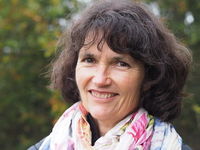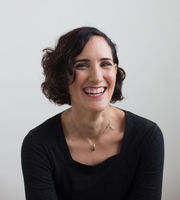Author & Illustrator team Susan Hughes & Carey Sookocheff on the Ups and Downs of Publishing
Who hasn't had the feeling that they don't fit in? Despite the universality of feeling excluded, odd, and unworthy, we still struggle to find a way to reach kids experiencing those feelings, to curb bullying in schools, and to even explain just how damaging bullying can be.
In Susan Hughes and Carey Sookocheff What Happens Next (OwlsKids), an unnamed narrator shares a stripped down story of her experiences at school. Hughes writing is stark and evocative: "What Her Friends Do: Laugh. What Everyone Else Does: Nothing ... How I Feel Sometimes: Bad. Really Bad." Sookocheff's artwork conveys the narrator's isolation in powerful graphic-novel style panels. Vancouver Kidsbooks called What Happens Next "an approach [to discussing bullying] that puts the power in the children's hands."
We're thrilled to welcome both Susan and Carey to Open Book today as this important book is published. For our newest interview series, Going Pros & Cons, we talk to creators about the publishing experience, their favourite moments, strangest surprises, and biggest frustrations.
Susan tells us about the sometimes-disorienting "hurry up and wait" timelines of publishing, shares her (invaluable!) advice for aspiring writers, and discusses the magic of seeing the artwork for her words. Carey shares how she got intrepid in going after her first break, tells us about her favourite part of the whole process, and describes her modest workspace essentials (including one furry bonus!).
My first big writing/publishing victory and how I celebrated:
Susan Hughes:
I completed my very first book, an upper middle-grade novel called Anything Can Happen, in 1990, after returning from my second trip to India. It was accepted for publication by Doubleday Press shortly afterwards and was published in 1992. I guess you could say my husband and I had our victory celebration sometime in between—our first child, Kevin, was born in May 1991!
Carey Sookocheff:
In 2014 I sent out a postcard to a small group of publishers in the hopes of getting some illustration work. Three publishers contacted me about developing the idea from the postcard into a picture book. I was also contacted about illustrating the Buddy and Earl series at around the same time. It was huge for me. In the end, that postcard resulted in my three publishing contracts. I’m pretty sure that my husband and I popped open a bottle of champagne, but I think I was so shocked that I just got down to work.
The thing that surprised me most about the publishing process:
SH:
The waaaaaaiiiiiitttiiiiinnnnnng and then the HURRYUP nature of the process still surprises me. It feels like the moments in between the writing, the submitting, the editing, the rewriting and revising, the editing, the rewriting and revising, the acceptance of the manuscript, the first looks at visuals, the look at the colour art, and so on—basically all the occasions when the manuscript is out of my hands and in someone else’s—are interminably long! And then the moments when I have the manuscript or visuals back in my hands zip by so quickly. Hang on, the editor needs my revision/comments back when?
CS:
I have been pleasantly surprised by how collaborative the process is and how valued my input and ideas are. I came to book publishing from editorial illustration, where there can be a lot of art direction. Given the time and effort that goes into a picture book, I was anticipating even more of that in publishing. Everyone I have worked with has been open to my ideas and curious to see what I can contribute to the project. I’ve ended up feeling very respected and valued working in publishing.
The advice I would give someone trying to get a book published for the first time:
SH:
Commit to the process. Have patience. Take a long-term view. Create your best work, submit, and begin another writing project. Be humble and take advice—but trust your passion.
CS:
Do your research! I would recommend reading lots of books and paying attention to who publishes them. Go to the library and the bookstore. Do research online by visiting publishers’ websites and be aware of what is happening in the book world. This will help you figure out where you fit in publishing and where is best to submit your manuscript or illustration work.
Your CanLit News
Subscribe to Open Book’s newsletter to get local book events, literary content, writing tips, and more in your inbox
My favourite part of the publishing process:
SH:
Oh, this is a tough question. I do love the editing process. I have worked with so many wonderful editors over the years—Stacey Roderick, Tara Walker, Karen Li, Niki Walker, Debbie Rogosin—and I have always just loved the back-and-forth with them, the exchange of thoughts and ideas about intention and word usage and style, the common striving to polish the manuscript until it is just right. I also love when the manuscript is good to go and we begin seeing the visuals come in—photos, for certain, but especially the illustrations. When an illustrator comes on board with a story as a co-creator, magic happens. Illustrators deepen and broaden the text, move it into another realm altogether, the way Carey did with What Happens Next! So much that is unsaid in this story is revealed through her sensitive and unique art. As I was writing WHN, I wondered how any illustrator could possibly come up with visuals for certain spreads in the book: for example, the ones in which the narrator describes genomes, describes how human bodies are primarily made of water, and describes the speed at which Earth spins around the Sun. Well, Carey found a way. She did it brilliantly!
CS:
My favourite part of the publishing process is when I am working on sketches and developing ideas. It is the time when there are an infinite number of possibilities and so many different directions to explore. It can also be the most frustrating time. There is often a lot of staring at blank paper and generating ridiculous ideas. The best part, though, is when those ideas start to come together.
The thing(s) I need at/in my writing space:
SH:
Give me my laptop and let me sit at a table near a window with a view. Oh, and maybe pour me a mug of coffee, too. That’s it. I’m all set!
CS:
I have a pretty short list of things I need where I work. The first thing is quiet. I don’t listen to music when I work and I am always the first one at the studio, so I usually have lots of quiet. Time is the second thing I need. I like to let ideas run around in my head for a while before they make it onto paper. And once those ideas are starting to form, I need a 2B pencil and a ton of paper. I often feel a great deal of guilt about the amount of paper I go through. Having my dog around is also nice.
_________________________
Susan Hughes is the author of over 30 children’s books, including Up! How Families Around the World Carry their Little Ones, Off to Class, and Making Canada Home. She is a freelance editor and story coach. She lives with her family in Toronto, Ontario. Find out more about Susan and her books at www.susanhughes.ca.
Carey Sookocheff is the illustrator of the critically acclaimed Buddy and Earl series, and the author/illustrator of Solutions for Cold Feet and Other Little Problems and Wet. She has worked with a wide range of editorial, design and corporate clients. She lives in Toronto with her husband, two kids, and their dog.





